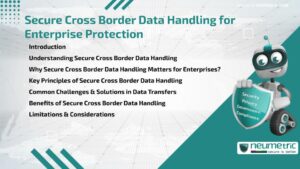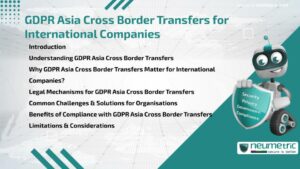Table of Contents
ToggleIntroduction
The SOC 2 type 2 implementation guide is a structured Framework that enterprises use to safeguard Sensitive Data & maintain trust with customers. It outlines detailed steps to evaluate Security Controls, measure their effectiveness over time & ensure alignment with Data Protection standards. By following this guide, Organisations can strengthen enterprise Data Protection, mitigate Risks & prepare for independent audits. This article explains the importance of SOC 2 Type 2, its key components, challenges, Best Practices & the role of Auditors in achieving compliance.
Understanding SOC 2 Type 2 & Its Importance
SOC 2 Type 2 is an advanced compliance Framework developed by the American Institute of Certified Public Accountants [AICPA]. Unlike SOC 2 Type 1, which only evaluates the design of Security Controls, SOC 2 Type 2 assesses their operational effectiveness over a period of six (6) to twelve (12) months.
For enterprises managing large volumes of Customer Data, this Certification demonstrates long-term commitment to security, confidentiality, availability, processing integrity & Privacy. It not only strengthens enterprise Data Protection but also builds trust with clients, partners & regulators.
Key Components of SOC 2 Type 2 Implementation Guide
A reliable SOC 2 type 2 implementation guide is built around five (5) Trust Service Criteria:
- Security: Protection of data from unauthorized access or breaches.
- Availability: Ensuring systems are accessible when needed.
- Processing Integrity: Delivering accurate & reliable data processing.
- Confidentiality: Maintaining strict controls over Sensitive Information.
- Privacy: Safeguarding Personal Information in compliance with Data Protection laws.
Each component provides a structured path for Organisations to strengthen internal controls & maintain consistent compliance.
Steps to achieve SOC 2 Type 2 Compliance
Enterprises can follow these essential steps when using a SOC 2 type 2 implementation guide:
- Conduct a Readiness Assessment – Identify gaps in current controls.
- Define scope – Choose systems, processes & Trust Service Criteria relevant to operations.
- Implement controls – Deploy Security Policies, Monitoring Tools & Risk Management frameworks.
- Document Evidence – Keep detailed records of how controls are implemented & followed.
- Engage auditors – Select accredited Third Party Auditors to verify compliance.
- Remediate findings – Address weaknesses highlighted during the Audit.
These steps ensure that compliance is not only achieved but also maintained over time.
Common Challenges in SOC 2 Type 2 Implementation Guide
While valuable, a SOC 2 type 2 implementation guide can present challenges:
- Resource allocation – Compliance requires significant time, budget & expertise.
- Complex documentation – Enterprises often struggle to maintain Evidence of controls.
- Evolving Threats – Security Measures need continuous updates to counter new Risks.
- Audit pressure – The extended review period can be demanding for Employees.
Recognizing these obstacles helps enterprises prepare more effectively.
Best Practices for Enterprise Data Protection
To maximize the benefits of a SOC 2 type 2 implementation guide, enterprises should follow Best Practices:
- Train Employees regularly on Data Security Policies.
- Use encryption for Sensitive Data both at rest & in transit.
- Establish Continuous Monitoring systems for real-time Threat detection.
- Perform regular internal audits to identify gaps before external reviews.
- Develop a clear Incident Response Plan for quick action during security events.
These practices reduce Vulnerabilities & ensure sustainable compliance.
The Role of Third Party Auditors
Independent Auditors play a central role in the SOC 2 type 2 implementation guide. They evaluate the effectiveness of controls over several months, provide unbiased reports & confirm compliance with Trust Service Criteria. Their validation is critical for enterprises that want to demonstrate accountability to external Stakeholders.
Limitations of SOC 2 Type 2 Compliance
Although beneficial, SOC 2 Type 2 compliance has limitations:
- It does not guarantee absolute security against breaches.
- It focuses only on controls within the defined scope.
- Audits are resource-intensive & may not capture all Risks.
Enterprises should view compliance as part of a broader Data Protection strategy rather than a complete solution.
Benefits of Following SOC 2 Type 2 Implementation Guide
Enterprises that follow a SOC 2 type 2 implementation guide gain several advantages:
- Stronger Data Security posture.
- Increased Customer Trust & confidence.
- Competitive advantage in regulated industries.
- Reduced Risk of penalties for non-compliance.
- Enhanced operational efficiency through standardised processes.
These benefits highlight the value of investing in compliance as a strategic priority.
Conclusion
The SOC 2 type 2 implementation guide provides enterprises with a clear path to secure Customer Data, meet compliance obligations & strengthen internal controls. While the process demands resources & effort, its impact on Data Protection & business trust is significant.
Takeaways
- SOC 2 Type 2 ensures operational effectiveness of Security Controls.
- Compliance requires readiness assessments, Control Implementation & independent audits.
- Challenges include resource demands, documentation & Audit rigor.
- Best Practices such as training, encryption & monitoring improve outcomes.
- Compliance should be integrated into a larger Data Protection Framework.
FAQ
What is the difference between SOC 2 Type 1 & SOC 2 Type 2?
SOC 2 Type 1 evaluates the design of controls at a point in time, while SOC 2 Type 2 tests their effectiveness over a longer period.
How long does it take to complete SOC 2 Type 2 compliance?
The process usually takes six (6) to twelve (12) months, depending on the scope & readiness of the Organisation.
Who needs to follow a SOC 2 type 2 implementation guide?
Enterprises handling Customer Data, especially in cloud services, Healthcare & Financial sectors, benefit most from SOC 2 Type 2 compliance.
Is SOC 2 Type 2 compliance mandatory?
It is not legally mandatory but is often required by clients, regulators & partners to demonstrate strong Data Protection.
What role do Employees play in SOC 2 Type 2 compliance?
Employees are essential as they follow Security Policies, maintain controls & support Audit documentation.
Can SOC 2 Type 2 prevent all data breaches?
No, compliance reduces Risks but does not eliminate them entirely. Enterprises must use additional Security Measures.
How often should SOC 2 Type 2 audits be performed?
Most enterprises undergo annual audits to maintain Certification & demonstrate continued compliance.
Need help for Security, Privacy, Governance & VAPT?
Neumetric provides organisations the necessary help to achieve their Cybersecurity, Compliance, Governance, Privacy, Certifications & Pentesting needs.
Organisations & Businesses, specifically those which provide SaaS & AI Solutions in the Fintech, BFSI & other regulated sectors, usually need a Cybersecurity Partner for meeting & maintaining the ongoing Security & Privacy needs & requirements of their Enterprise Clients & Privacy conscious Customers.
SOC 2, ISO 27001, ISO 42001, NIST, HIPAA, HECVAT, EU GDPR are some of the Frameworks that are served by Fusion – a SaaS, multimodular, multitenant, centralised, automated, Cybersecurity & Compliance Management system.
Neumetric also provides Expert Services for technical security which covers VAPT for Web Applications, APIs, iOS & Android Mobile Apps, Security Testing for AWS & other Cloud Environments & Cloud Infrastructure & other similar scopes.
Reach out to us by Email or filling out the Contact Form…





